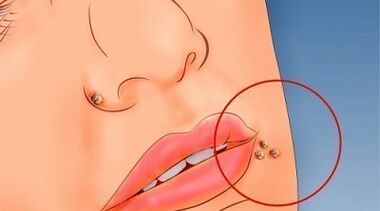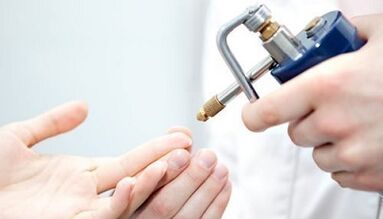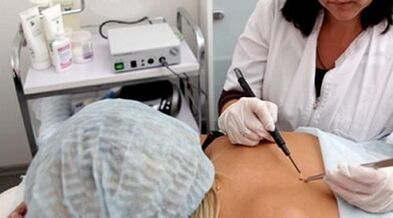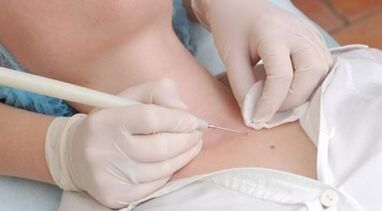The papilloma virus is easily transmitted from person to person, infection with him manifests itself in the form of warts.Treatment of warts is a complex process that should begin with diagnostic measures.The doctor - dermatologist will be able to help choose the treatment.
Types of treatment of warts.The most effective methods of struggle

Warts or papillomas is harmless benign neoplasms that spoil the appearance of the skin.Since this phenomenon does not look aesthetically aesthetically pleasing, every person in whom they have is trying to get rid of warts in all possible ways.But you also need to get rid of them competently, because papillomas can have malignant subtext and instead of getting rid of skin infection, you will acquire a serious cancer.
Warts are dense skin nodules, the size of which reaches a large pea, with an uneven surface.Most often, the background of the hands, palms and fingers are subjected to warts.In some people, warts can be found on the face, lips, axillary hollows, and legs.
Those warts that are located on the sole of the feet are the most painful.They can reach large sizes and bring a lot of discomfort to their owners.Most often, people in retirement age are subject to plantar warts.
Before proceeding with treatment, a person needs to consult a specialist in order to confirm that this neoplasm is just a wart.Various methods can be used to remove them: from creams and gels to surgery and the use of traditional medicine.In each case, the doctor prescribes the treatment of warts and papillomas individually.
Cryodestruction
The most common method of riding the skin from papillomas and warts is destruction of their liquid nitrogen.A similar procedure is called cryodestruction.The effect on the affected skin is carried out using liquid nitrogen, which reaches a minus of 190 degrees.The wart is frozen, the neoplasm cells are cooled and the freezing of water inside the cell tissue leads to their rupture, and this destroys the papilloma.Under the influence of liquid nitrogen, the affected tissue dies, there are no scars left on the site of the former neoplasm.
The methodology of the operation

The freezing procedure is carried out using cryozond or manual method using cotton sticks.The manual method is the most popular, as it does not require large costs from the clinic.
The patient may need anesthesia if:
- The neoplasm is large.
- Papilloma is located on the sensitive area of the skin.
- Mandatory anesthesia is subjected to a place of removal of neoplasms in children.
The procedure itself boils down to the implementation of simple mechanical movements: the doctor dipped a cotton stick into the drug of liquid nitrogen and touches the neoplasm, slightly pressing.The exposure time is limited only to the size of the neoplasm and its type.Sometimes re -processing of the tissue of the neoplasm with nitrogen is required in order to completely destroy its structure.The re -cauterization procedure is necessary for plantar warts.
At the site of exposure, signs of a burn are manifested, a similarity with thermal lesion is observed.A bubble with liquid appears on the skin.It is these conditions that show the process of complete destruction of papilloma.
Electrocoagulation
A safe and effective way to eliminate various skin neoplasms, which is also used to cure any type of wart.Electrocoagulation allows you to eliminate only the upper skin growth, but will not get rid of the human papilloma virus itself.The probability of relapse is possible in more than half of cases, so it is necessary to approach the solution of the problem comprehensively.
Features of the procedure
The method of electrocoagulation allows you to get rid of such a cosmetic defect quickly, but there is always a risk of scar tissue at the exposure site.

And no specialist will be able to guarantee complete getting rid of such neoplasms.
Since removal is carried out using an electronic loop with high temperature, this makes the method less safe compared to folk external drugs.
Therefore, before the use of serious destructive methods of struggle, it is necessary to try all means of traditional medicine.Since folk recipes are safer and have a lower risk of scar tissue.
Contraindications
For the treatment of a wart by electrocoagulation, it is necessary to consult with a specialist and identify possible individual contraindications.
General contraindications include:
- The presence of any auxiliary devices for the cardiovascular system (cardiomonitor or stimulator, rhythm driver).
- Contraindications associated with high current intolerance.
- Allergic reactions to anesthetic drugs.
- Inflammatory processes in an acute body, which are the result of the presence of infectious diseases.
- Hemophilia and vascular disorders at the level of capillaries.
The use of the method of electrocoagulation is not recommended from plantar warts, since with this effect the risk of the development of scars is great.Firmly cicatricial fabric will prevent you from walking correctly.
Recovery period
Additional drug treatment after the destruction by an electric car is not required.But rarely, additional prevention of warts is carried out by taking antiviral drugs.
Antiseptic wound processing is all that is required to restore after surgery.
The only thing that needs to be performed for several days is processing by any skin antiseptic a place of exposure.
Laser exposure
Who at least once searched for methods how to treat warts effectively knows that the laser effect is the safest.The use of a laser in aesthetic cosmetology will help get rid of various neoplasms and not leave the scar.The advantage of execution is exactly the effects of rays.
Before curing papillomas with this method, you need to consult with a specialist and undergo a certain examination.
The process of execution and consequences
The operation is performed under local anesthesia, so the patient will be proposed to undergo examination for blood diseases and tolerance of such an effect.Those who are worried about possible complications from Laser exposure should carefully approach the choice of a specialist, because the safety of the procedure depends only on his qualifications.The doctor selects the necessary depth of exposure to the laser and cauterizes.
The effect of high laser temperatures allows you to completely destroy the malicious neoplasms, without damage to healthy ones.After such an effect, bleeding is not formed, since the laser seals blood vessels and the blood does not go outside.
After the procedure, in order to avoid the appearance of cicatricial tissue, it is necessary to use the medicine of traditional medicine - tincture of calendula.Do not apply alcohol lotions to the scene, this can cause irritation and complicate the healing of tissues.
Contraindications

Despite all the safety of the application of this method, it is not recommended to be used for:
- Pregnancy.During the period of hormonal changes at the site of exposure, a tumor neoplasm may form in the form of a scar, which will be difficult to remove.
- The procedure is impossible for patients with the presence of cancer.
- Hormonal changes in the body during puberty and in the menopause are the same contraindication as the operation during pregnancy.
Drug treatment
Modern medicine far stepped forward in the treatment of warts.Therefore, in each pharmacy you can find a large number of various means to eliminate the external signs of human papilloma virus.
The use of these tools is possible without consulting a specialist, but such self -medication can provoke cancer of the skin.Therefore, not every wart can be treated independently.It is best to seek a consultation with a specialist and then use drug treatment with papilloma.
Phenolic subgroup preparations with antiviral effect
Each of the drugs of this group has in its composition antibacterial and antiviral components that allow superficially affecting the neoplasm.
A specialist selects the necessary drug, but the use of such products gives a visible effect only after a month of use.
Means of traditional medicine
To eliminate the visible manifestations of the presence of a human papillomavir in the body, it is necessary to use folk remedies.Since they are gentle methods of influence, they should be tried first.
Celandine
The scope of celandine is not limited to exposure to the skin.A powerful and poisonous plant, which has a large number of alkaloids in its composition, has been effectively used to eliminate warts for many years.Treatment can last from several days to several months, depending on the severity of the neoplasm.
Celandine juice is smeared on a wart several times a day.The visible effect with a slight manifestation of the virus is observed from the first days of application.

From celandine, you can also prepare a healing ointment based on glycerol, which can be stored in the refrigerator for a long time.
It can be applied to no more than five neoplasms at the same time, since the celandine has strong components that can cause burns.
Some patients may observe allergic reactions to the use of celandine, so it is necessary to test the skin reaction in a small area.
Acetic acid
To eliminate skin neoplasms, a concentrated solution of acetic acid can also be used.This method is affordable both in price and use.Daily processing of a wart with acetic acid will help get rid of the neoplasm in a matter of days, without harm and consequences.
Ascorbic and salicylic acid
A daily reception of several balls of ascorbic helps to raise immunity and increase the body's resistance to the human papillomavirus.Some time after taking the drug, a decrease in the amount and size of neoplasms is noted.But ascorbic acid can be used not only inward, it can be wiped with the place of accumulation of papillomas.
Salicylic acid equally with other means of struggle against warts helps to stop their manifestations if you use more than two weeks.The product is applied to the wart with a cotton swab at night, sealed with a patch.















